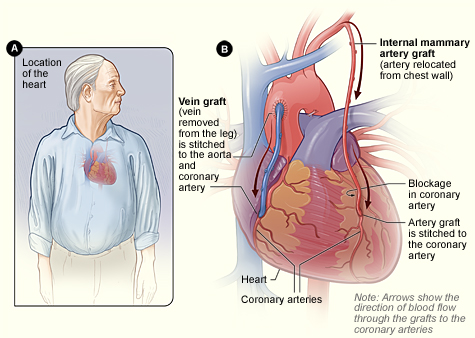What Is Coronary Artery Bypass Grafting?
Coronary artery bypass grafting (CABG) is a type of surgery that improves blood flow to the heart. Surgeons use CABG to treat people who have severe coronary heart disease (CHD).
CHD is a disease in which a waxy substance called plaque (plak) builds up inside the coronary arteries. These arteries supply oxygen-rich blood to your heart.
Over time, plaque can harden or rupture (break open). Hardened plaque narrows the coronary arteries and reduces the flow of oxygen-rich blood to the heart. This can cause chest pain or discomfort called angina (an-JI-nuh or AN-juh-nuh).
If the plaque ruptures, a blood clot can form on its surface. A large blood clot can mostly or completely block blood flow through a coronary artery. This is the most common cause of a heart attack. Over time, ruptured plaque also hardens and narrows the coronary arteries.
CABG is one treatment for CHD. During CABG, a healthy artery or vein from the body is connected, or grafted, to the blocked coronary artery. The grafted artery or vein bypasses (that is, goes around) the blocked portion of the coronary artery. This creates a new path for oxygen-rich blood to flow to the heart muscle.
Surgeons can bypass multiple coronary arteries during one surgery.
Coronary Artery Bypass Grafting

Figure A shows the location of the heart. Figure B shows how vein and artery bypass grafts are attached to the heart.
Overview
CABG is the most common type of open-heart surgery in the United States. Doctors called cardiothoracic (KAR-de-o-tho-RAS-ik) surgeons do this surgery.
However, CABG isn't the only treatment for CHD. Other treatment options include lifestyle changes, medicines, and a procedure called coronary angioplasty (AN-jee-oh-plas-tee).
Angioplasty is a nonsurgical procedure that opens blocked or narrow coronary arteries. During angioplasty, a stent might be placed in a coronary artery to help keep it open. A stent is a small mesh tube that supports the inner artery wall.
CABG or angioplasty may be options if you have severe blockages in your large coronary arteries, especially if your heart's pumping action has already grown weak.
CABG also may be an option if you have blockages in the heart that can't be treated with angioplasty. In this situation, CABG may work better than other types of treatment.
The goals of CABG may include:
- Improving your quality of life and reducing angina and other CHD symptoms
- Allowing you to resume a more active lifestyle
- Improving the pumping action of your heart if it has been damaged by a heart attack
- Lowering the risk of a heart attack (in some patients, such as those who have diabetes)
- Improving your chance of survival
Outlook
The results of CABG usually are excellent. The surgery improves or completely relieves angina symptoms in most patients. Although symptoms can recur, many people remain symptom-free for as long as 10 to 15 years. CABG also may lower your risk of having a heart attack and help you live longer.
You may need repeat surgery if blockages form in the grafted arteries or veins or in arteries that weren't blocked before. Taking medicines and making lifestyle changes as your doctor recommends can lower the risk of a graft becoming blocked.
Clinical trials are research studies that explore whether a medical strategy, treatment, or device is safe and effective for humans. To find clinical trials that are currently underway for Coronary Artery Bypass Grafting, visit www.clinicaltrials.gov.
March 27, 2012
NIH study shows survival advantage for bypass surgery compared with non-surgical procedure
A new comparative effectiveness study found older adults with stable coronary heart disease (CHD) who underwent bypass surgery had better long-term survival rates than those who underwent a non-surgical procedure to improve blood flow to the heart muscle, also called revascularization.

When a heart attack happens, any delays in treatment can be deadly.
Knowing the warning symptoms of a heart attack and how to take action can save your life or someone else’s.
The NHLBI has created a new series of informative, easy-to-read heart attack materials to help the public better understand the facts about heart attacks and how to act fast to save a life.
Click the links to download or order the NHLBI's new heart attack materials:
“Don’t Take a Chance With a Heart Attack: Know the Facts and Act Fast” (also available in Spanish)
“Heart Attack: Know the Symptoms. Take Action.”
“Learn What a Heart Attack Feels Like—It Could Save Your Life”
The NHLBI updates Health Topics articles on a biennial cycle based on a thorough review of research findings and new literature. The articles also are updated as needed if important new research is published. The date on each Health Topics article reflects when the content was originally posted or last revised.















